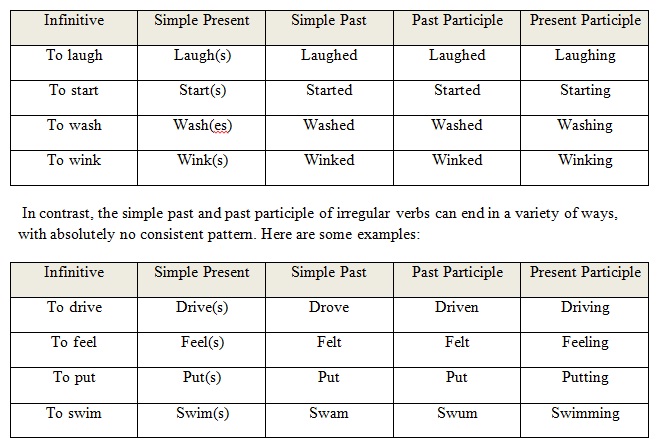
He has been an English teacher and teacher trainer for over 15 years. – modifying nouns: You can spend the enclosed money on whatever you likeįor this reason, the past participle form is also referred to as verb 3, and that’s what we use in the table below. – forming the passive voice: 1000 widgets are produced in the factory every day – forming the perfect aspect: I have already eaten / He had arrived In English, verbs like ‘play’ is regular as it follows the ‘-ed’ pattern in past simple, ‘played’. On the other hand, regular verbs follow a pattern for past and past participle, like ed, -d,-ied. The past participle form also has different functions, for example: Its past is ‘went’ and past participle is ‘gone’. Referring to it as the “past tense form” can therefore cause confusion, and in the table below we refer to it as verb 2. This is because it also has other functions, such as in unreal conditionals and to talk about wishes in the present. The past tense form (so-called because of its use with this tense) is also referred to as verb 2. Here’s a list of some of the more common irregular verbs. What are some common irregular verbs in English? Irregular verbs are formed differently, for example: Base form Regular verbs do follow this pattern, for example: Base form
PATTERNS IN ENGLISH IRREGULAR VERBS FULL
All irregular verb forms are given in full at the main dictionary entry.An irregular verb is one which does not follow the normal pattern of “base form + ed” in the past tense form and past participle form. If you aren’t sure how a verb behaves, it’s best to look it up. There are many more irregular verbs in English than those listed here. Note that sometimes the spelling doesn’t change but the pronunciation does (e.g. Here are the forms of some of the most common irregular verbs: Verb There are many irregular verbs that don’t follow the normal rules. hurry/hurrying, clarify/clarifying).įor more detail, see Verb tenses: adding-ed-and-ing. If the basic form ends in y just add - ing (e.g. If the verb ends in e, drop the e before adding - ing (e.g. If the basic form of the verb ends in a consonant or a vowel other than e, add the ending - ing (e.g. To make the present participle of regular verbs: To form the past participle of regular verbs, follow the same rules as for the past simple tense above.

play/played, enjoy/enjoyed).įor more detail, see Verb tenses: adding-ed-and-ing.
PATTERNS IN ENGLISH IRREGULAR VERBS PLUS
But if the verb ends in a vowel plus -y, just add -ed (e.g. If the verb ends in a consonant plus -y, change the y to an i before adding -ed (e.g. In English there are regular verbs as well as irregular verbs. A verb whose conjugation follows a different pattern is called an irregular verb. seem/seemed, laugh/laughed, look/looked).įor verbs that end in -e, add -d (e.g. A regular verb is any verb whose conjugation follows the typical pattern, or one of the typical patterns, of the language to which it belongs. To English learners, the trickiest irregular verbs are the ones that have different present tense, past. If the basic form of the verb ends in a consonant or a vowel other than e, add the letters - ed to the end (e.g. Irregular Verbs With Different Forms in Every Tense. Past tense formationįorming the past simple tense of regular verbs is mostly straightforward, and you use the same form for the first, second, and third persons, singular and plural: English Center Coordinator Christopher Heuer, Professor English Math Center Coordinator. But if the verb ends in a vowel plus -y, just add -s (e.g. If the verb ends in a consonant plus - y, change the y to an i before adding - es (e.g. kiss/kisses, fizz/fizzes, punch/punches, wash/washes, mix/mixes). Verbs that end with -s, - z, -ch, - sh, and -x add -es (e.g.

Verbs that end with a vowel other than e add - es (e.g. Most verbs just add - s to the basic form (e.g. In the present simple tense, the basic form of a regular verb only changes in the 3 rd person singular, as follows:

Many English verbs are regular, which means that they form their different tenses according to an established pattern. This section deals with inflecting verbs to show tenses and participles, and is divided into two main sections: first person, second person, or third person). In the context of verbs, we use the term inflection to talk about the process of changing a verb form to show tense, mood, number (i.e. What's The Difference Between Regular And Irregular Verbs?


 0 kommentar(er)
0 kommentar(er)
